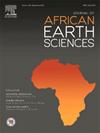Vanadium distribution and behavior in the Paleoproterozoic of the Reguibat Shield: insights from statistical and geochemical analyses
IF 2.2
4区 地球科学
Q2 GEOSCIENCES, MULTIDISCIPLINARY
引用次数: 0
Abstract
Reliable geochemical databases for vanadium ores in thin the vast Precambrian domains of the West African Craton are insufficient to establish regional deposition model that can help in its exploration. Despite the economic interest in vanadium is rapidly expanding, the limited number of geochemical and mineralogical studies focused on its deposition and accumulation in the region restricts our understanding of its behavior and hinders the discovery of potentially exploitable ore deposits. In this study, conducted as part of the Tiris Uranium Project, data from 1195 geochemical analyses using the ICP-MS method, performed on 1065 borehole samples, were statistically processed using Python. The objective is to characterize the geochemical behavior of vanadium and the processes responsible for its concentration in Precambrian granites and surface colluvium of the Reguibat Shield in northern Mauritania. Our results indicate that vanadium behaves as a high field strength element (HFSE) in granites, with a particular concentration in hydrothermalized context. Vanadium shows a strong affinity for FeOt and TiO2, preferentially concentrating in ferromagnesian-rich granites and titaniferous minerals such as iron oxides, biotite, and ilmenite.
求助全文
约1分钟内获得全文
求助全文
来源期刊

Journal of African Earth Sciences
地学-地球科学综合
CiteScore
4.70
自引率
4.30%
发文量
240
审稿时长
12 months
期刊介绍:
The Journal of African Earth Sciences sees itself as the prime geological journal for all aspects of the Earth Sciences about the African plate. Papers dealing with peripheral areas are welcome if they demonstrate a tight link with Africa.
The Journal publishes high quality, peer-reviewed scientific papers. It is devoted primarily to research papers but short communications relating to new developments of broad interest, reviews and book reviews will also be considered. Papers must have international appeal and should present work of more regional than local significance and dealing with well identified and justified scientific questions. Specialised technical papers, analytical or exploration reports must be avoided. Papers on applied geology should preferably be linked to such core disciplines and must be addressed to a more general geoscientific audience.
 求助内容:
求助内容: 应助结果提醒方式:
应助结果提醒方式:


